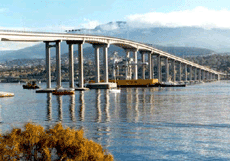![]()
![]()
The original Hobart floating bridge that the Tasman Bridge replaced
![]()
Tasman Bridge during construction. Part of the floating bridge can be seen to the left of the new bridge
![]()
The bridge being rebuilt
![]()
![]()
The bridge after the collision

The Tasman Bridge today. The gap where the missing span once stood can be seen on the far left of the photograph
![]() Cars park in the former ramp onto the old Hobart floating bridge Cars park in the former ramp onto the old Hobart floating bridge
|
The original Tasman Bridge across the Derwent River, which the current bridge replaced, was a unique floating bridge which was opened in 1943. By 1955, constant damage to it by storms and high seas and its inability to handle the increased traffic using it led the Tasmanian Government to build a replacement.
![]()
That replacement, Tasman Bridge, today links the city of Hobart to the suburbs on the eastern shores of the River Derwent. As the water to be spanned by the bridge would span was close to 50% wider than the channel spanned by the Sydney Harbour Bridge, yet needed to be as high as that bridge to allow the passage of medium sized cargo vessels, it was decided to build a bridge supported by a series of piers supporting nineteen spans, with a single navigation span over the deepest part of the river, which would be the apex of the bridge. Allowing for a span width of 42.7 metres, the bridge would have 13 spans to the west of the navigation span and 6 to the east.
The major part of the bridge is founded on either basalt or dolerite at depths up to 160 feet below water level. Beneath Piers 4 to 8, the dolerite is as much as 300 feet below water surface and is overlaid by very stiff clays, a thin layer of coarse gravel and shingle, very stiff sandy loam and conglomerate. The underside of the central navigation span is around 48 metres above mean water level.
Construction commenced in May,1960 and the bridge was first opened to traffic (2 lanes only) on 18th August, 1964. By 23rd December, all four lanes became operational. The first ship to pass under bridge, Galway, did so on 18th August 1964. During peak construction a labour force of over 400 men was employed on site. The total cost of the new Tasman Bridge together with approach roads and Lindisfarne interchange was in the order of £7 million.
Tasman Bridge Disaster
On the evening of Sunday, 5th January, 1975 at 9.27 pm, the bulk ore carrier "SS Lake Illawarra" loaded with zinc concentrate, drifted out of the main navigation lane and collided with the Tasman Bridge. Two piers collapsed along with 127 metres of decking. It was drizzling and after dark, so visibility was poor. Bridge traffic kept coming over the rise in the bridge and hurtling into the river below. One driver became aware of the collapsed span. He stopped his car and tried to warn others, but most of them took no notice and kept going to their deaths. Four cars ran over the gap into the Derwent, five occupants died, while several others managed to escape from their vehicles which were hanging on the edge of the gap. Seven crewmen from the "SS Lake Illawarra" also lost their lives.
The impact of the bridge collapse was quickly felt as Hobart was suddenly cut in two. Eastern shore residents were severely compromised, transport facilities were tested and to compound the issue further, most hospitals, schools, businesses and government offices were located on the western shore. By the next day, three private ferries and a government vessel were in operation. Health services also needed to be addressed and within four months most of the essential services needed by Clarence residents had been provided.
Weeks after the collision a decision had been made to construct a temporary bridge north of the damaged Tasman Bridge, in order to restore a direct road link between Hobart and the eastern shore. The Bailey Bridge was opened to traffic on 16th December 1975. It provided one lane of traffic each way on a temporary structure crossing at Dowsings Point.
Immediately after the Bridge collapsed, the Federal and State Governments set up the Joint Tasman Bridge Restoration Commission to direct the reconstruction of the Bridge. Specialists in the marine engineering field undertook an extensive investigation to locate bridge debris. This survey took a number of months to complete, and parts of the bridge weighing up to 500 tonnes were located to an accuracy of a few centimetres, using equipment developed by the University of Tasmania and the Public Works Department.
Maunsell and Partners were appointed consultants for the rebuilding project. John Holland Contractors were awarded the contract. The Federal Government funded the project which began in October 1975. Engineers decide not to replace pier 19 as there is too much debris on the site, and so only one pier was replaced and two spans of the three spans that were brought down in the collision were replaced by a single, new span. The Tasman Bridge was initially designed to carry four lanes of traffic, however prior to the disaster, heavy demands had been placed on the bridge during peak times. It was decided to widen the bridge as part of the reconstruction works to carry five lanes of traffic. The Bridge took about two years to re-build at a cost of approximately $44 million, which was around three times its initial cost thanks to inflation. The Tasman Bridge was officially re-opened to the public on Saturday 8th October, 1977.

View Larger Map
|